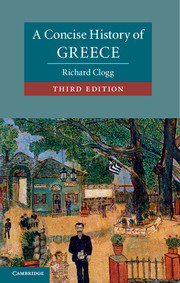Book contents
- Frontmatter
- Dedication
- Contents
- List of Illustrations
- Preface
- 1 Introduction
- 2 Ottoman rule and the emergence of the Greek state 1770–1831
- 3 Nation building, the ‘Great Idea’ and National Schism 1831–1922
- 4 Catastrophe and occupation and their consequences 1923–49
- 5 The legacy of the civil war 1950–74
- 6 The consolidation of democracy and the populist decade 1974–90
- 7 Balkan turmoil and political modernisation: Greece in the 1990s
- 8 Greece in the new Millennium: from affluence to austerity
- Biographies
- The Royal Houses of Greece
- Presidents
- Tables
- Key Dates
- Guide To Further Reading
- Index
Biographies
Published online by Cambridge University Press: 05 June 2014
- Frontmatter
- Dedication
- Contents
- List of Illustrations
- Preface
- 1 Introduction
- 2 Ottoman rule and the emergence of the Greek state 1770–1831
- 3 Nation building, the ‘Great Idea’ and National Schism 1831–1922
- 4 Catastrophe and occupation and their consequences 1923–49
- 5 The legacy of the civil war 1950–74
- 6 The consolidation of democracy and the populist decade 1974–90
- 7 Balkan turmoil and political modernisation: Greece in the 1990s
- 8 Greece in the new Millennium: from affluence to austerity
- Biographies
- The Royal Houses of Greece
- Presidents
- Tables
- Key Dates
- Guide To Further Reading
- Index
Summary
constantine 1, king of the hellenes (1868–1922)
King of Greece 1913–17: 1920–2. Eldest son of King George I (q.v.) and Queen Olga. Trained as a soldier in Athens and Germany. Married Sophia, the sister of Kaiser Wilhelm II. During 1897 Greek–Turkish war commanded Greek army in Thessaly.Made a scapegoat for defeat. Appointed to high rank in the army in 1900, he and the other royal princes were required to resign after the Goudi military coup of 1909. Appointed commander-in-chief by Prime Minister Eleftherios Venizelos in 1911, his command of Greek forces during the Balkan wars of 1912–13 meant that, by the time of his accession to the throne in 1913 on the death of his father George I, he enjoyed considerable popularity. On the outbreak of the First World War he quarrelled with Venizelos over Greece’s alignment, Venizelos favouring the Entente, Constantine neutrality. These disagreements resulted in the ‘National Schism’ and the establishment by Venizelos in 1916 of a rival provisional government in Salonica. Constantine was forced to leave Greece as a result of British and French pressure in June 1917. He did not formally abdicate and was replaced by his second son, Alexander. Following Alexander’s death in October 1920 and Venizelos’ surprise defeat in elections the following month, Constantine, following a dubious plebiscite, returned to the throne in December 1920. In 1922, after the defeat of the Greek armies in Asia Minor, he was overthrown in a coup led by Colonel Nikolaos Plastiras (q.v.). He was succeeded by his eldest son, George, who ruled as George II (q.v.). Three months later Constantine died in exile in Palermo.
- Type
- Chapter
- Information
- A Concise History of Greece , pp. 264 - 283Publisher: Cambridge University PressPrint publication year: 2013

